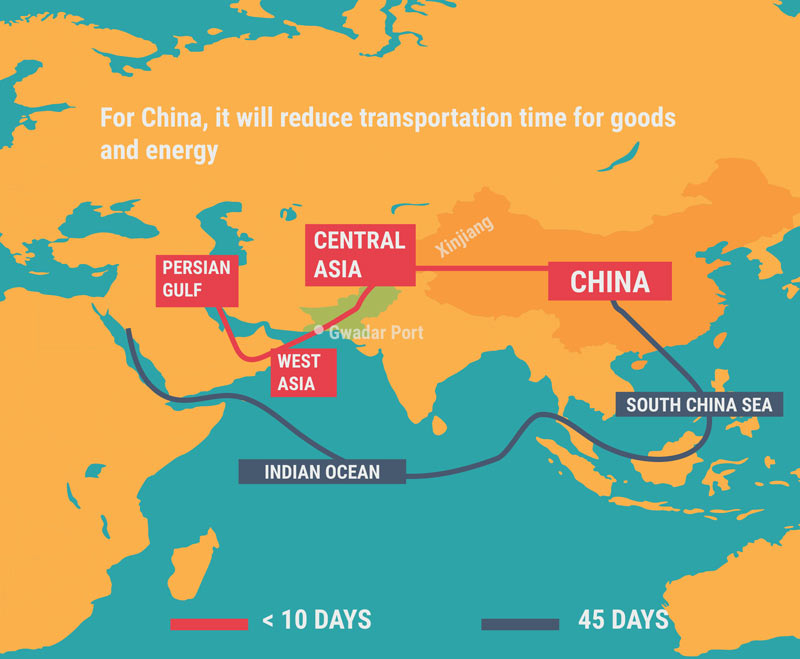
Image Courtesy: Wali Zahid
https://bharatshakti.in/the-grand-global-corridors-china-pakistan-economic-corridor/
Editor’s Note
Over the last two centuries, many a corridor for trade and trasit have been created by the world’s super rich nations. The Panama Canal is one such example that continues to count the passage of thousands of ships annually. Similarly there are rail links and roads that have provided a boost to trade and have been a part of geo-political objectives of major powers. However, there is a difference when it boils down to CPEC. In the other cases, there has been an investor nation and country(s) in which investments have been poured; in the case of CPEC the equation is of debtor and creditor nation(s) with China being assured of its returns even before projects have started operations.
THE GRAND GLOBAL CORRIDORS & CHINA PAKISTAN ECONOMIC CORRIDOR
China and Pakistan make an odd couple with only a deep geopolitical commitment to each other. Politically, economically, culturally and religiously they are as different as chalk from cheese. China is a near super power, rich, ambitious, atheistic and autocratic. Pakistan on the other hand is a near failed state, poor, deeply religious and politically unstable. Will this odd couple make a success of the CPEC? There is a lot at stake since CPEC is the flagship of the greatest economic corridor to be visualized – OBOR. This is being debated and discussed all over. It is this context that it would be relevant to see how some of the great economic corridors of the past have fared. Their success or failure has pointers to where things are going to go. I have picked three economic corridors with proven credentials – the Panama Canal, the Berlin Baghdad Railway and the Suez Canal as subjects of study. I have chosen the Trans Baluchistan Railway (Yes. There was one) to highlight a point in the Pakistani context. Based on the outcomes, an analysis has been attempted to see how CPEC could fare. Whether this odd couple beats history is for you to judge.
The Panama Canal
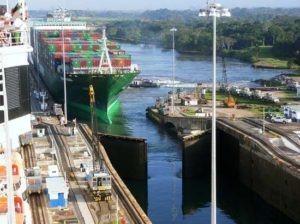
Image Courtesy: Encyclopedia Britannica
The 83km long Panama Canal began its operation in 1914. It was built by the United States mainly to connect its Eastern and Western coasts and avoid sailing around South America. To build and control the Panama Canal, USA created a nation called Panama by carving it out from Colombia in 1903. As per a treaty, USA has “as if it were sovereign” rights to the Panama Canal “in perpetuity” though it is being run by Panama today. In 1914, annual traffic through the Canal was about 1,000 ships which grew to more than 815,000 vessels in 2012. It is termed as one of the seven wonders of the modern world. Its annual revenue is 2 billion USD. It is the biggest contributor to Panama’s GDP.
Panama has had a turbulent political and economic history since 1914 with wild swings. By 1983 it was in economic ruin and hugely indebted to the IMF and the World Bank. Street protests and military repression were rampant. Manuel Noriega became its dictator in 1983 with US support. He set up a criminal and parallel economy based on drugs, human trafficking of Chinese migrants and money laundering. As the cat’s paw of USA, Noriega supported guerrilla uprisings in neighboring countries. Political opponents were assassinated. Finally, he turned coat on the USA too. Retaliatory US sanctions destroyed the Panamian economy. Ultimately USA had to invade Panama in 1989 to safeguard its interests; primarily the Panama Canal. The invasion pushed large sections of urban population to below poverty levels and caused destruction of property between 1.5- 2 billion dollars. Since then, Panama has successfully stabilized – politically and economically. However, it has taken them more than 75 years to do so and this has been possible largely because of the interests of the USA in Panama Canal. In fact, in a loose sense, Panama can be termed as an “Independent” State of the USA with limited sovereignty. Call it a colony? I leave it to your imagination. Despite a recent economic boom and its upper-middle per capita GDP, Panama has great educational disparities and over 25% of Panama’s population live in poverty.
After a hundred years of successful operation, the Panama Canal has benefitted USA immensely as also many other countries in the region and world. Has it benefitted Panama as much? It continues to be a mosquito and insect infested tropical country with bouts of economic ruin, civil strife and political instability. Its sovereignty is questionable. Without the USA, it might collapse.
The Berlin Baghdad Railway
In the late 19th century the Ottoman Empire was weakening and in financial trouble. Europeans saw great economic opportunity to exploit the resources of the weakening empire i.e., irrigation which could transform their agricultural requirements and minerals in the form of chrome, antimony, lead and zinc mines and some coal. Not to mention the abundant oil of the Middle East. The idea of a trans-continental rail link through the Ottoman Empire was born. There was a lot of competition between the British, French and Germans – being the main contenders. Ultimately, the Germans won out. Work began at the turn of the 20th Century. It was known as the Berlin-Baghdad Railway.
The Baghdad Railway was built from 1903 to 1940 to connect Berlin with Baghdad. It was to be extended by 1600 km through modern-day Turkey, Syria, and Iraq to Basra, in the Persian Gulf. The German interest was to counter the British Empire by avoiding the Suez Canal, Turkey’s interests were twofold: Countering its Russian rivals and control of Arabian Peninsula as well as expansion of influence across the Red Sea into Egypt which had been under British military control. The latter was to be done by an offshoot called the Hejaz railway which was from Allepo to Damascus to Medina. Incidentally the Hejaz Railway was the one which was attacked by Lawrence of Arabia. He never let it function fully by inflicting a death by thousand cuts through guerrilla warfare.
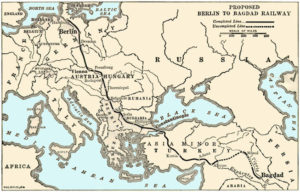
Image Courtesy: GlobalSecurity.org
Had it had been completed in time, the Berlin – Baghdad (and ultimately Basra) Railway would have enabled transportation of goods from Germany to the warm waters of the Gulf. From there trade goods and supplies could be exchanged with the farthest of the German colonies, and the world. The return journey would have given direct supply of oil to Germany. The idea was to bypass British control of shipping and threaten British dominance in colonial trade. The Railway also threatened Russia, since it was axiomatic that political influence would follow economic interests. The Railway might have eventually strengthened the Ottoman Empire and its ties with Germany and might have shifted the balance of power in the region. Similarities to the CPEC in many respects are eerie though predated by a century. Funding, engineering and construction was mainly provided by Germany. The Railway became a source of international disputes prior to World War I. It has also been ascribed to be a leading cause of World War I. When World War 1 broke, the Railway was still 960 km away from its intended objective. By 1915, the Railway was still 480 km short. Its utility and use during the War was limited. Baghdad was captured by the British while the Hejaz Railway in the south was sorted out by Lawrence of Arabia. Construction resumed in the 1930s. The last stretch to Baghdad was built in the late 1930s and the first train to travel from Istanbul to Baghdad departed in 1940.
Did it serve the purpose for which it was envisaged? Clearly no. By the time the Railway was built, empires and nations ceased to exist the way they were. Colonial contours had changed. Technical difficulties, funding issues, cultural outlooks, geopolitical alignments and divergent interests stretched construction time to breaking point. The project was so contentious, big and ambitious that it was bound to fail on all fronts. And -it failed-never to meet any one’s aspirations.
Suez Canal
The Suez Canal connects the Mediterranean Sea to the Red Sea. It was constructed between 1859 and 1869. It was officially opened on November 17, 1869. The Canal has been in operation for nearly a century and a half, shortening the journey between the Atlantic and Indian Oceans by 7000 km. In the year 2012, as many as 17,225 vessels traversed the Canal (47 per day). Initially the Canal was owned by the Britishers. Nasser nationalized it. The Canal is now owned and maintained by the Suez Canal Authority of Egypt. In August 2014, construction was launched to expand and widen the Canal to double its capacity from 49 to 97 ships a day. The “New Suez Canal”, was opened on 6 August 2015. In the fiscal year 2014-15, the revenues of the Canal were 5.7 billion USD. This is bound to increase in the coming years.
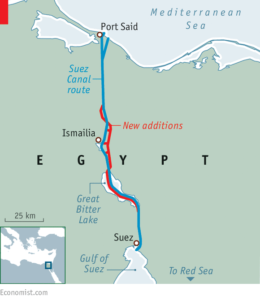
Image Courtesy: The Economist
Let us look at the Egyptian economy. After all, a booming and profitable Suez Canal should have given stability and progress to Egypt over the past century and a half. However, the opposite is true. President Nasser ran a centralized planned economy in true Soviet style. External strife in the form of Arab- Israel wars debilitated growth. After mending fences with Israel, the 90s saw a series of IMF arrangements. It received external debt relief due to participation in the Gulf War coalition. Egyptian macroeconomic performance improved. Since 2000, structural reforms helped Egypt move towards a market-oriented economy and prompted increased foreign investment. The reforms and policies propelled growth, which averaged 8% annually between 2004 and 2009. However, trickle-down effect was poor. Wealth distribution was inequitable. Economic conditions of the population worsened. Unemployment burgeoned. After the 2011 revolution, Egypt’s foreign exchange reserves fell from $36 billion in December 2010 to only $16.3 billion in January 2012. Standard &Poor lowered Egypt’s long-term credit rating from B- to CCC+ in 2013. Egypt has seen peaceful growth only for about two decades. Barring that it has been involved in strife – Externally or internally. After the Arab Spring, growth rates have plummeted to 2-3%. Double digit inflation has crossed 20%. Interest rates have broken glass ceilings. The economy is heading to be a basket case.
A case of contrasts clearly emerged in Suez Canal and Egypt. The stark message is that successful projects do not guarantee growth of nations or people. Good governance and peace leads to growth. Strife and unrest hamper growth. Most importantly political instability leads to stagnation, delays and flight of capital. Military governments cannot handle people and growth.
Trans Baluchistan Railway
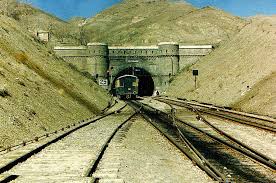
Image Courtesy: Pinterest
The “Trans–Baluchistan Railway” is not an economic corridor in the true sense. It was constructed as part of a strategic military route between Quetta and Zahedan prior to World War 1. The Quetta to Nushki branch line opened in 1905. The railway line reached the Iranian town of Zahedan in 1922. By the time the railway line reached Zahedan, the British had already demobilized their forces in East Persia (in March 1921). The newly built railway lost relevance. In 1931, part of the link was closed. World War II renewed interest in the Quetta-Zahedan link. British forces wanted to aid the Soviet forces by supplying material through Persia. The aid never materialized but the Quetta-Zahedan link reopened in April 1940. An extension of this line was the Quetta Chaman line onwards to Afghanistan. This line traversed over the Khojak Pass through the Khojak Railway Tunnel, located at a height of 1945 meters above sea level and 153 km away from Quetta and goes straight to Afghanistan. It is also known as Shela Bagh Tunnel; constructed in 1891 is still one of the longest tunnels in South Asia.
It is very pertinent to note that, way back in the colonial era, the British Raj constructed extensive railway lines, roads, bridges, airports, telegraph lines and strategic garrisons all over the present-day Baluchistan. Infrastructure build up was extensive for that time and era. The massive investment in infrastructure was however for colonial purposes – exploitation of the colony and thwarting Russian advance towards the warm waters of Baluchistan. The economic intent was never there. Local interests were never in picture. Is a similar thing being repeated with CPEC? Neglect of local interest. Chinese are interested in their aims. Pakistan or its progress is not their concern.
My Analysis
Very surprisingly, all corridors including CPEC have a pairing of a rich and stable country – USA, Germany, UK and China which have initiated the project in a weak, poor and unstable country – Panama, Egypt, Turkey and Pakistan. Very clearly in all cases economic corridors have been about progressing geopolitical or strategic interests and making money for the investing country and very less to do with growth of the host nation. In all cases nothing much has changed for the host country despite the corridors being an economic success. If anything, the host country tends to suffer partial loss of sovereignty to the bigger partner. In the process, it will be arm twisted heavily. This sounds ominous for Pakistan as far as the CPEC is concerned. One thing for sure Pakistani fate will change for the worse if CPEC comes through and the Governance remains poor, lack of transparency continues and corruption levels are what they are. Political instability, geopolitical disputes, lack of international cooperation, natural disasters and financial mismanagement might back fire on the project through time delays and cost escalation; which would lead to collapse of the project.
One key factor differentiates the CPEC from the rest of the projects. In all projects, there has been an investor nation and an invested nation. In this case there is a creditor nation and a debtor nation. Very funnily, the creditor has been indemnified and guaranteed profits even before the project has taken off by the debtor who is in near financial ruin with a huge population bubble coming up. China gets what it wants irrespective of what happens in Pakistan! In case all goes well as per plans China reaps profits in every sense. In case the project sputters, China gets a colony! What happens to Pakistan? Pakistanis can answer it themselves. In my opinion, the Achilles heel of the CPEC lies in this creditor-debtor modelling.
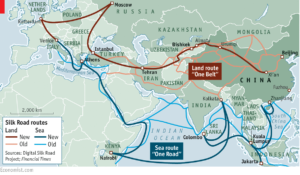
Image Courtesy: The Economist
However, if Pakistan loses, China will also lose. China loses by losing the trust of the world. In which case, the OBOR model can wait for the next century. Last but not the least, corridors get waylaid by the Lawrences’ of this world. Given Pakistani strategic behavior since Independence, enough Lawrences have been self-created to strike at the CPEC. So far Pakistan has been able to run with the Hare and hunt with the Hound. That’s over. Hereafter many hounds will hunt the Pakistani Hare.
POST SCRIPT: A Pakistani comment on my earlier article on CPEC was that they do not need Indian Generals to advise them as to what to do. I agree with it. Pakistanis should listen to their own Generals who have lost half of Pakistan for them. Also, who am I to advise Pakistan when I am not heeded even in India! But –
I am glad that people across are reading me. I invite my readers to post their valuable comments. Comments of all kind are welcome from all quarters.
Lt Gen P R Shankar (Retired)
(Disclaimer: The views and opinions expressed in this article are those of the author and do not necessarily reflect the official policy or position of BharatShakti.in)

Comments
Post a Comment